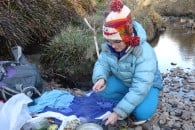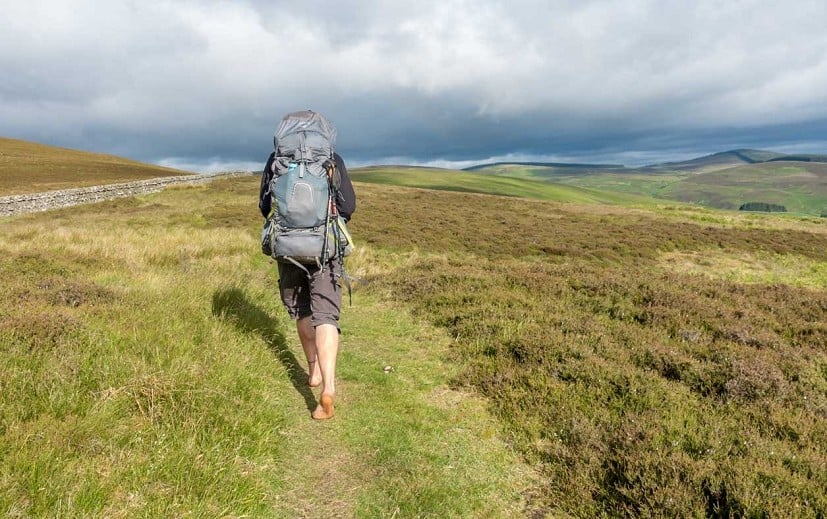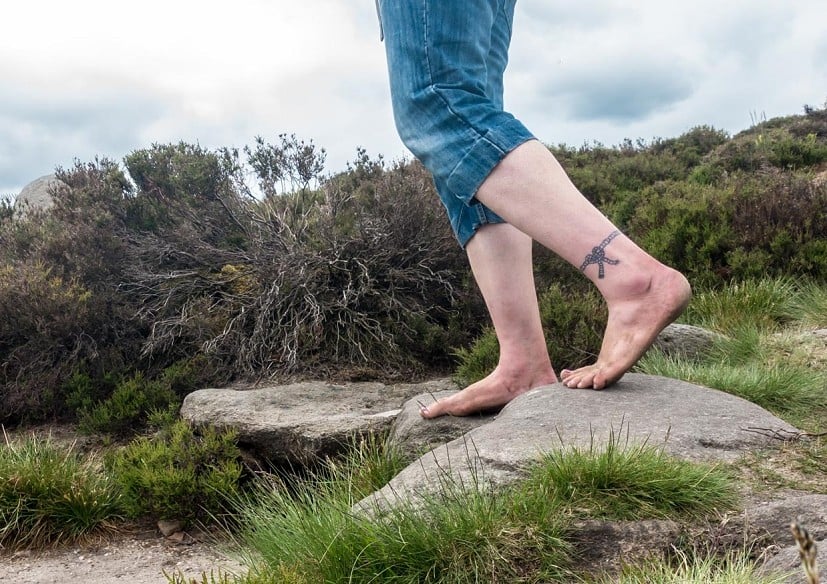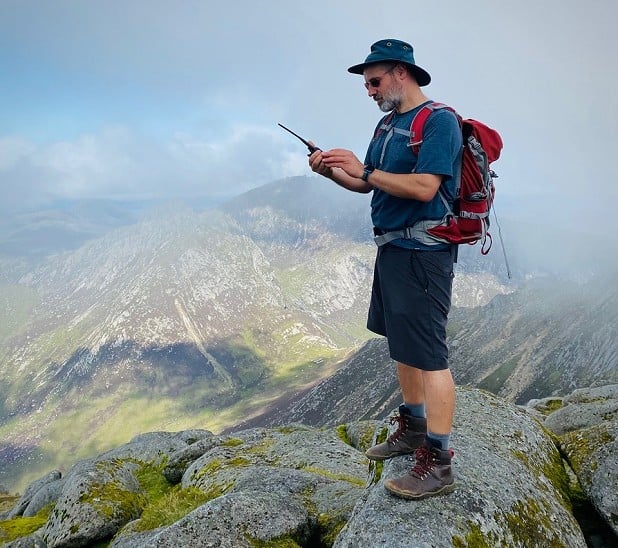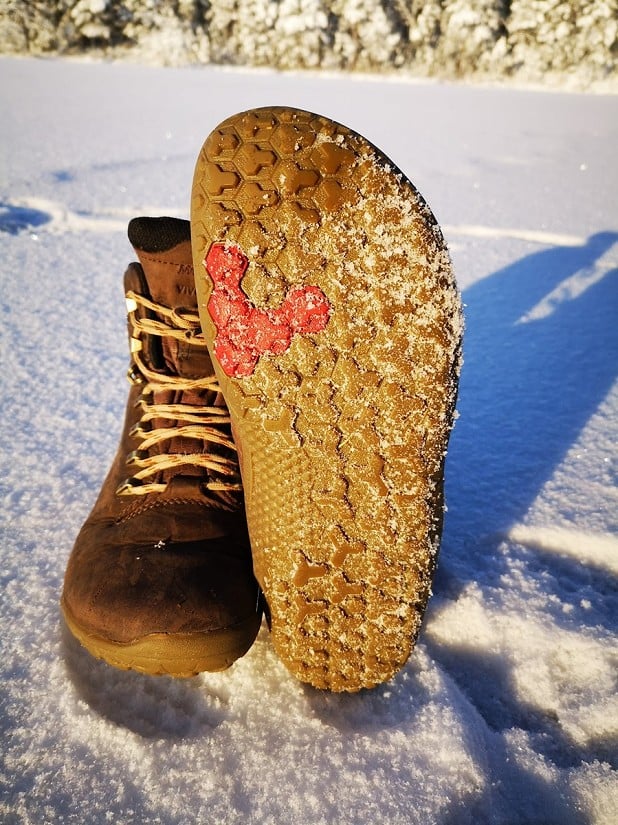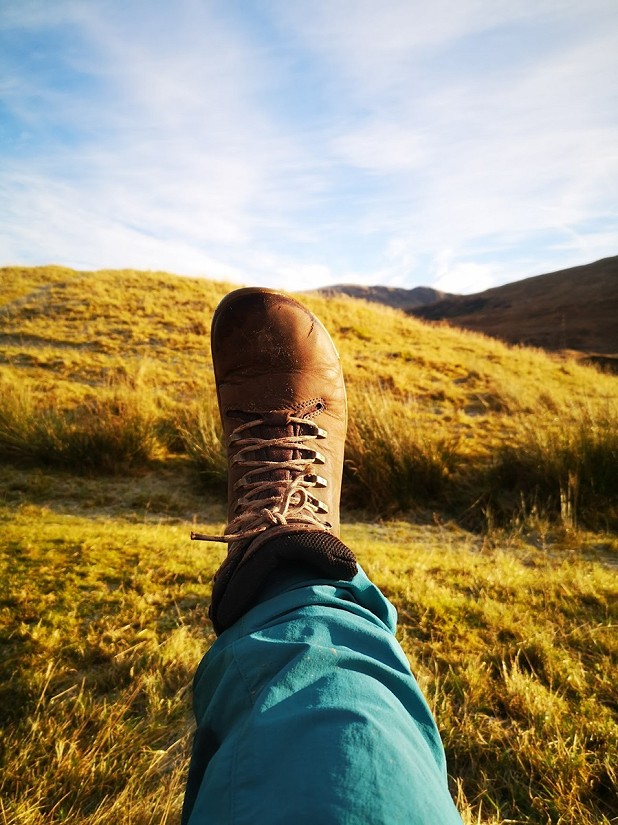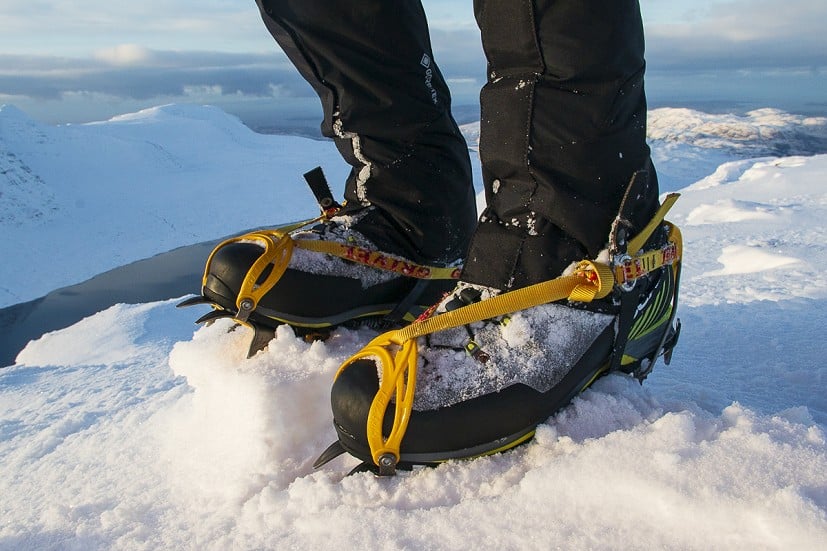Barefoot Walking - Dipping a Toe in the Water
Barefoot running has been a thing for years, but what about taking this approach into the hills? Do rocks hurt more, are bogs that bit wetter, and do your feet get tired over a long Munro day? Fliss Freeborn examines the pros and corns of swapping the usual chunky and supportive walking footwear for something modishly minimalist.
In 2009, American Journalist Christopher McDougall wrote Born to Run, a bestselling non-fiction book documenting the ultra-running feats of members of the indigenous Mexican Tarahumara tribe. Members of the tribe, who from childhood wear just thin rubber sandals, run until they're well into old age, reputedly never getting injured while going for hundreds of miles at a time across desert, canyons and hills. The central thesis of the book is that modern running shoes, invented only in the 1980s, are responsible for many running injuries: a radical - and thus far contentious - claim, but one which nonetheless helped spawn a 1.7 billion dollar 'barefoot' shoe industry that is still going strong over a decade later.
In boots it feels like I have boxes on my feet. Barefoot, there is a real sense of connection with the ground
If you've not come across the barefoot movement, the theory goes that without highly cushioned, structured footwear, the foot adapts to the ground below, strengthening the specialised podiatry muscles, ligaments and cartilage over time. When given the space to do so, the toes naturally spread out and provide better stability, and any impact is more evenly distributed over the ball of the foot, rather than being centred around a heel strike - which relieves subsequent pressure and torque on the ankle, knees, hips and spine. For the avoidance of doubt, barefoot shoes are also known as minimalist shoes; all are characterised by having thin, uncushioned soles, wide or no toe boxes, zero drop (no difference in height between heel or toe) and little to no arch support. They mimic being barefoot but offer some protection from both impact trauma, and thermal discomfort.
The scientific consensus on barefoot running, however, is inconclusive. Leaky methodologies, small sample sizes, and conflicting results of systematic reviews mean that there is no clear cut answer to the question of whether shod vs unshod running is "better" for biomechanical health across populations and, crucially, running surfaces. And if there's little watertight evidence for the advantages of barefoot running, the science behind barefoot hillwalking (astute readers will have noticed that this is actually a hillwalking website) is practically tumbleweed.
My own theory is that because recreational hillwalking is both less competitive and lower impact than running, the need for shoe companies to either prove or disprove any biomechanical advantage is lessened. Then there's the fact that Christopher McDougall didn't name his bestseller Born to Walk. But without conclusive science behind things, why is there a barefoot hillwalking movement in the first place? Are there any other advantages to feeling the ground beneath your feet?
Ian, the creator behind the Barefoot Backpacker travel blog, is - unsurprisingly - a long-term advocate of ditching traditional shoes. In 2019, Ian walked across Britain from the most easterly point to the most westerly, a length of over 950 miles, in a mix of lightweight xero sandals, Skinners (a sock-like shoe) and completely unshod where the trail allowed. When asked why they've switched to barefoot, they said:
"What I found when I went barefoot more is that I felt lighter on my feet, and the act of walking itself became more pleasurable. Now, closed shoes just make me feel like I'm wearing bricks on my feet, and walking in them just feels more like a drudge than a pleasure."
"Being barefoot gives me better grip, it also makes the area covered by my feet smaller and thinner so it's easier to stand on narrower rocks and pebbles, plus I can bend my feet and toes around the contours of the terrain allowing more efficient movement. I also feel quicker and more nimble, and I don't feel like I'm pressing down as hard on the ground, which means my steps are lighter and I'm almost bouncing across the turf."
When I asked about how they cope with cold feet when hiking in the UK, Ian said:
"I feel the cold less (and the warm more) than most people. That's not to say I'm going to be found wandering barefoot atop the snowy Edges in the Peak District at dawn in mid-February of course.
"To be honest, most of my hiking and hillwalking takes place in warmer times of the year, and the problem isn't so much cold feet as the rest of my body being overly warm. My feet get too hot and uncomfortable in conventional shoes, so being in minimalist sandals, shoes, or even completely barefoot helps me keep cool and comfortable, and makes me feel I can keep going longer."
If there's little uncontested evidence for the advantages of barefoot running, the science behind barefoot hillwalking is practically tumbleweed
Ian takes barefoot walking quite literally, but the movement is a spectrum. Other people opt to wear shoes boasting flexible soles which allow users to feel what's going on beneath their feet, also allowing for their toes to spread out - but which on first glance look like any other shoe. One such advocate is Christian Payne, a documentary maker and writer who has been wearing minimalist shoes for 11 years:
"I switched to minimal shoes after chatting with one of the best shoemakers in the world" he tells us.
"After asking him how I can best look after my feet and my health, wondering if it was to commission him to make me a custom pair of shoes, he told me the best thing for healthy strong feet is no shoes.
"It was not long after that I tried Vibram and then Vivobarefoot. After about three months my body adjusted to a new walking style and I never looked back. All the hiking and most of the walking I have done in the last 11 years has been in minimal shoes. The only rigid soled shoes I have are motorbike boots and a pair of wellies."
Christian hikes in a pair of Vivobarefoot Tracker IIs (pictured), the shoe that looks much like a conventional walking boot but has a thinner sole, wide toe box and flexible upper. He feels he is much more nimble since switching to barefoot boots and feels his foot strength has greatly improved. When asked how walking barefoot feels in comparison to conventional shoes, Christian says:
"I'm certainly more mindful when walking because there is a real sense of connection with the ground. But this feels natural and the right way. Otherwise I don't really think about my footwear unless I find myself in borrowed boots. Then it feels like I have shoeboxes on my feet. Losing touch with the subtleties of the terrain feels cumbersome."
What's it like to make the switch?
I have been curious enough to try sampling the subtleties of the terrain for myself. So after a little bit of research about what would stand up to the most abuse without completely bankrupting me, I too opted for a pair of Vivobarefoot Tracker IIs, reduced to half price at an online outlet.
For serious winter walking, barefoot shoes are absolutely no match for a pair of rigid boots
Much to my surprise, these have been so comfortable that they've replaced my trusty Timberlands as an everyday shoe, as well as for hikes where I'd usually wear trail running shoes. The Vivos have held up to everything from going up hills, to mountain biking, to pubbing, to dog walking, to dancing, to driving. I suspect years of wearing crocs have helped my feet adapt to shoes that have a wide toe-box and little in the way of structure; it has now been several months of near constant use and I have no pain, soreness or other complaints.
Upon adjusting to his shoes, Christian said: "I had an achy lower back for a couple of months and then my body seemed to not only realign, all of the niggles I felt from years of carrying a camera bag went away."
Unlike traditional walking boots, the minimalist version feel like slippers straight out of the box - they're very light on the feet and sometimes I forget I'm even wearing them. There's no need to break them in either (Christopher actually went on a 22 mile walk in his minimalist shoes straight after buying them) and as someone who is usually terribly blister-prone, I've not suffered at all just yet.
They performed amazingly on autumnal hill walks, and I've felt nimble, quick, and ready to jump over candlesticks, plus my feet have stayed dry throughout too - one of my main worries about the suspiciously lightweight boot. And although the lugs aren't the beasts you see on other walking shoes or boots, I feel like I've gained stability by being able to feel what's under my feet more readily, as well as having my toes spread out for a wider surface area underfoot.
But, there's always a catch (or two)
However, I don't want this article to turn into a 2000 word advert for Vivobarefoots - because there are two or three aspects where barefoot shoes don't stand up to regular walking boots.
The first of these is their unsuitability for winter walking: the soles of barefoots are designed to be thin and flexible, so absolutely will not be negotiating with a crampon anytime soon. Sure, you could fit some over-shoe spikes - and I might just do that at some point if it does get icy around Glasgow - but you will lack the foot protection and rigidity necessary to kick and hold an edge in hard snow. For serious winter walking they're absolutely no match for a pair of B1s or B2s and some trusty Grivels.
There's also the aspect of temperature: while I wore my Vivos around Sweden in minus 13 for the first few days and was just about ok, I was more comfortable switching to a pair of snow boots in the end. So no, they're not designed with the deepest, darkest winter hill days in mind - but that said, the heat-reflected inserts have been effective enough in the UK so far, even walking on frozen tracks and paths. I just wouldn't want to stand about in the cold for long.
Another aspect where the barefoots aren't good as traditional hiking boots is on spiky or particularly boggy terrain. Navigating a decent scree slope, for example, might leave you with slightly sore tootsies, and they just feel altogether less trustworthy than a pair of heavy boots for questing across difficult ground like elephant grass, sphagnum or heather on a bearing.
This is especially true if you're carrying a heavy pack and habitually wear high topped boots with plenty of ankle support; the aim of the barefoot boots is to make your foot and ankle naturally more stable, so loading untrained ankles with an extra 25% of your body weight straight away could be a risky strategy. Ian of the Barefoot Backpacker manages perfectly well with a heavy pack, but this is due to years of building up strength by going barefoot. Personally, I've not minded carrying heavier loads with the barefoots, but I've forgone traditional hiking boots for a few years in favour of trail shoes (or, yes, crocs), which has also helped with my own ankle stability.
A contentious issue within the barefoot discussion is the focus on 'natural' movement in a rather unnatural environment. Many of the warnings from podiatrists around barefoot shoes are to do with tiny stress fractures occurring from continuous impact on very hard running surfaces. Viewed from this end of the telescope, much of the criticism of the barefoot movement (aside from it being MegaCulty™) is actually a criticism of the surfaces on which we're expected to live out our daily lives: going without any squish if you're spending hours pounding concrete, tarmac or any other unforgiving urban environment can be detrimental to foot health, and many podiatrists recommend cushioning if you exercise in these conditions.
Happily, however, lots of hillwalking is a) less impactful than running and b) takes place on textured, undulating terrain, which is, on occasion, quite soft. This means that minimalist hillwalking should be easier to adapt to than minimalist running, while gently strengthening your feet, ankles and calves and letting you feel more at one with the ground below - provided you're not walking the Cape Wrath Trail with a 25kg pack for your first barefoot outing. It's certainly made my own (non-winter) hillwalking more enjoyable, and I'd be keen to get out for some more scrambling as soon as the weather allows, to really put that grip and flexibility to the test.
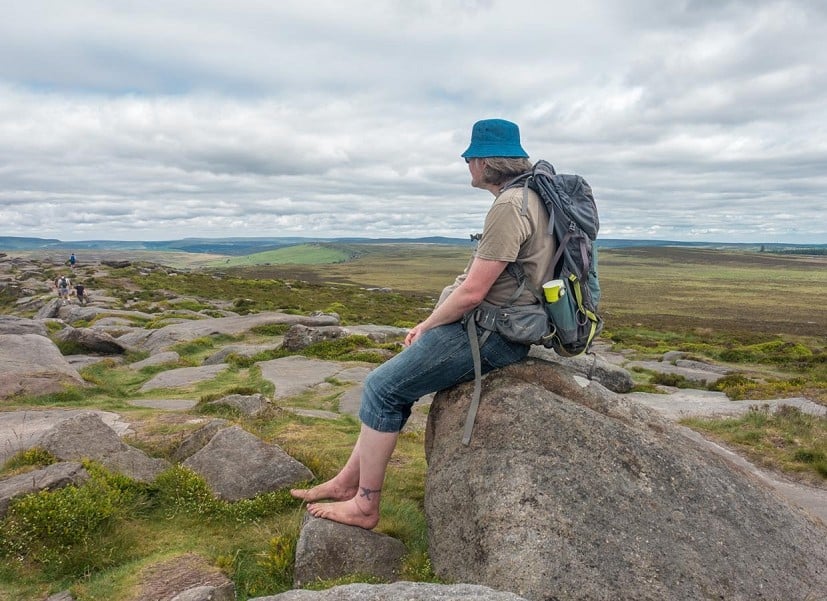
So, if this article has made you curious about going barefoot, we have some beginner-friendly tips:
Start slowly
If you've spent your whole life in structured shoes, going completely barefoot can feel odd. Start by taking your shoes off on grass or sand for a few hundred metres, and really paying attention to whether, or how, your gait changes. Your body will adjust quite quickly, but make sure you are noticing when and where your heel strikes in particular. By going barefoot - quite literally barefoot - you'll know exactly how your natural gait feels before you decide whether you like it enough to invest in a pair of minimalist shoes.
Ian says, "the biggest effect I've found is the more you do it, the more your feet get used to doing it, so it becomes easier to manage the different textures and terrains you walk on. They stop feeling weird and awkward, and start feeling natural and comfortable. It quickly becomes natural to move your foot into certain positions, and your muscles learn. Or maybe re-learn – children do it naturally before we put them in shoes, so I guess we're just going back to what we do innately."
Don't invest upfront
If you're interested but can't think of anything worse than having dirty feet, and/or don't want to spend upwards of £150-200 on a new pair of nearly-shoes, start by buying a pair of water-activity shoes off Amazon. These start at around £18 and are minimalist enough (zero drop, wide toe-box) to give a good feel for good weather barefoot walking without haemorrhaging your rent money.
When the fun stops, stop
This applies to everything from eating pasta, to booze, to relationships, to exercising, but especially barefoot hillwalking. If you find your feet are more sore after a day of wearing minimalist shoes than wearing conventional shoes, it's time to reassess the context in which you're doing it; if you have continued foot pain, stop wearing them altogether and see a podiatrist.
Don't put all your toes in one basket
It might also be important to keep your feet adaptable to other types of shoes if you do anything other than walking or running, as over time your feet might change shape if left to their own devices. Ian also comments on muscle use; that, "the downside [of barefoot hillwalking] is it means switching from one to the other is a bit risky unless you build up to it, since the chance of muscle strain is much higher – I'd find it really hard now for instance to do a Parkrun in running shoes."
The majority of friends I know who are minimalist runners or walkers don't wear their thin soled-shoes all the time, and I probably won't either - despite my satisfaction with barefoot boots in general, I still want to be able to cram my poor toes into climbing shoes or ski touring boots from time to time. Plus, if I only wore barefoot shoes the whole time, I might have to start growing my hair long, make noises about starting a commune, and talk incessantly about how corporate greed is the real enem…oh. Whoops.
